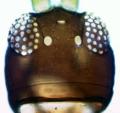Aeolothrips collaris
Recognition data
Distinguishing features
Both sexes with complete, banded wings. Body and legs brown, pronotum usually yellow, antennal segment II yellow in about apical half, segment III extensively yellow. Head and pronotum with no long setae. Fore tarsus apically with stout recurved ventral hamus. Antennae 9-segmented, segment III with linear sensorium short, IV with sensorium more than half length of segment and curved distally; segments V–IX forming a single unit with V slightly longer than VI–IX. Marginal setae on sternites arising at or close to margin; sternite VII supernumerary paired setae arising well in front of margin.
Male tergites IV and V with paired dorsal tubercles; setae at base of claspers on tergite IX shorter than clasper, with stout curved seta lateral to clasper.
Variation
The pronotum is sometimes brownish yellow rather than clear yellow.
Related and similar species
A. collaris is a member of the Eurasian species-complex that includes A. fasciatus and A. intermedius. Females with the pronotum brown are very similar to brown females of A. auricestus but have the median pair of setae on sternite VII further apart, however the males are readily distinguished because of the stout pair of curved setae ventrolateral to the claspers in A. collaris (see zur Strassen 2003: 49). Just over 90 species are placed currently in the genus Aeolothrips, of which more than 50 are from the Palaearctic Region (mainly Europe), and 28 from the Nearctic (mainly western USA). Only two species are recorded from the Neotropics; the one from Chile is probably the same as A. fasciatus, and one from Panama is probably not a member of this genus (Mound & Marullo, 1996).
Taxonomic data
Current valid name
Aeolothrips collaris Priesner
Original name and synonyms
- Aeolothrips fasciatus var. collaris Priesner, 1919: 119
- Aeolothrips fulvicollis Bagnall, 1919: 253
- Aeolothrips perclarus Melis, 1932: 156
- Aeolothrips brevicinctus Bagnall, 1934: 125
- Aeolothrips palaestinensis Priesner, 1935: 318
- Aeolothrips collaris subsp. meridionalis Priesner, 1948: 324
Family placement
Aeolothripidae
Biological data
Life history
Flower-living, but probably a facultative predator with a mixed diet of pollen and the larvae of other thrips. In California, collected from Alfalfa flowers in association with western flower thrips on which adults and larvae were predatory.
Host plants
Found in the flowers of a range of plants, with no recorded specificity.
Tospoviruses vectored
None
Crop damage
None recorded
Distribution data
Area of origin
Southeastern Europe
Distribution
Widespread from southern Europe, around the Mediterranean to Madeira and the Canary Islands and east to India and Bangladesh; introduced to California.






